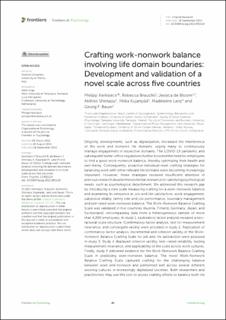| dc.contributor.author | Kerksieck, Philipp | |
| dc.contributor.author | Brauchli, Rebecca | |
| dc.contributor.author | de Bloom, Jessica | |
| dc.contributor.author | Shimazu, Akihito | |
| dc.contributor.author | Kujanpää, Miika | |
| dc.contributor.author | Lanz, Madeleine | |
| dc.contributor.author | Bauer, Georg F. | |
| dc.date.accessioned | 2022-09-20T11:44:20Z | |
| dc.date.available | 2022-09-20T11:44:20Z | |
| dc.date.created | 2022-09-16T08:45:01Z | |
| dc.date.issued | 2022 | |
| dc.identifier.citation | Kerksieck, P., Brauchli, R., de Bloom, J., Shimazu, A., Kujanpää, M., Lanz, M. & Bauer, G. F. (2022). Crafting work-nonwork balance involving life domain boundaries: Development and validation of a novel scale across five countries. Frontiers in Psychology, 13, Artikkel 892120. | en_US |
| dc.identifier.issn | 1664-1078 | |
| dc.identifier.uri | https://hdl.handle.net/11250/3019131 | |
| dc.description.abstract | Ongoing developments, such as digitalization, increased the interference of the work and nonwork life domains, urging many to continuously manage engagement in respective domains. The COVID-19 pandemic and subsequent home-office regulations further boosted the need for employees to find a good work-nonwork balance, thereby optimizing their health and well-being. Consequently, proactive individual-level crafting strategies for balancing work with other relevant life domains were becoming increasingly important. However, these strategies received insufficient attention in previous research despite their potential relevance for satisfying psychological needs, such as psychological detachment. We addressed this research gap by introducing a new scale measuring crafting for a work-nonwork balance and examining its relevance in job-and life satisfaction, work engagement, subjective vitality, family role and job performance, boundary management and self-rated work-nonwork balance. The Work-Nonwork Balance Crafting Scale was validated in five countries (Austria, Finland, Germany, Japan, and Switzerland), encompassing data from a heterogeneous sample of more than 4,200 employees. In study 1, exploratory factor analysis revealed a two-factorial scale structure. Confirmatory factor analysis, test for measurement invariance, and convergent validity were provided in study 2. Replication of confirmatory factor analysis, incremental and criterion validity of the Work-Nonwork Balance Crafting Scale for job and life satisfaction were assessed in study 3. Study 4 displayed criterion validity, test–retest reliability, testing measurement invariance, and applicability of the scale across work cultures. Finally, study 5 delivered evidence for the Work-Nonwork Balance Crafting Scale in predicting work-nonwork balance. The novel Work-Nonwork Balance Crafting Scale captured crafting for the challenging balance between work and nonwork and performed well across several different working cultures in increasingly digitalized societies. Both researchers and practitioners may use this tool to assess crafting efforts to balance both life domains and to study relationships with outcomes relevant to employee health and well-being. | en_US |
| dc.language.iso | eng | en_US |
| dc.rights | Navngivelse 4.0 Internasjonal | * |
| dc.rights.uri | http://creativecommons.org/licenses/by/4.0/deed.no | * |
| dc.title | Crafting work-nonwork balance involving life domain boundaries: Development and validation of a novel scale across five countries | en_US |
| dc.type | Peer reviewed | en_US |
| dc.type | Journal article | en_US |
| dc.description.version | publishedVersion | en_US |
| dc.rights.holder | © 2022 Kerksieck, Brauchli, de Bloom, Shimazu, Kujanpää, Lanz and Bauer. | en_US |
| dc.source.volume | 13 | en_US |
| dc.source.journal | Frontiers in Psychology | en_US |
| dc.identifier.doi | https://doi.org/10.3389/fpsyg.2022.892120 | |
| dc.identifier.cristin | 2052281 | |
| dc.source.articlenumber | 892120 | en_US |
| cristin.ispublished | true | |
| cristin.fulltext | original | |
| cristin.qualitycode | 1 | |

